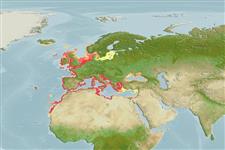Environment: milieu / climate zone / depth range / distribution range
Ecologie
marien; zoet water; brak water; katadroom (Ref. 51243); diepte 10 - 20 m (Ref. 7399). Temperate; 64°N - 20°N, 26°W - 42°E
Eastern Atlantic: Scotland to Cape Verde; in the Mediterranean and Black Sea. Also in coastal waters from southern Norway to Morocco, rare off Mauritania (Ref. 3573). Records from the lagoon of Accra are probably misidentifications.
Lengte bij maturiteit / Grootte / Gewicht / Leeftijd
Maturity: Lm 34.0 range ? - ? cm
Max length : 61.0 cm FL mannelijk / geslacht onbekend; (Ref. 117745); common length : 30.0 cm SL mannelijk / geslacht onbekend; (Ref. 7399); max. gepubliceerd gewicht: 2.5 kg (Ref. 117745)
Dorsale stekels (totaal): 5; Dorsale zachte stralen (totaal): 7-9; Anale stekels 3. Longer pectoral fins, lack of black spot at the pectoral fin base. Golden spot present in gill cover (Ref. 35388).
Adults are neritic usually in schools, entering lagoons and lower estuaries (Ref. 7399); rarely entering freshwater (Ref. 3573, 59043). Juveniles move to coastal lagoons and estuaries in winter and especially in spring (Ref. 59043). They feed on small benthic organisms, detritus, and occasionally on insects and plankton (Ref. 2804). Juveniles feed only on zooplankton (Ref. 59043). Reproduction takes place in the sea, from July to November. Oviparous, eggs are pelagic and non-adhesive (Ref. 205). Minimum size allowed for fishing is 20 cm. The quality of the flesh is variable (Ref. 30578).
Juveniles move to coastal lagoons and estuaries in winter and especially in spring (Ref. 59043).
Thomson, J.M., 1986. Mugilidae. p. 344-349. In J. Daget, J.-P. Gosse and D.F.E. Thys van den Audenaerde (eds.) Check-list of the freshwater fishes of Africa (CLOFFA). ISNB, Brussels, MRAC; Tervuren; and ORSTOM, Paris. Vol. 2. (Ref. 3573)
Status op de Rode Lijst van het IUCN (Ref. 130435)
Gevaar voor de mens
Harmless
Gebruik door de mens
Visserij: commercieel; Aquacultuur: commercieel
Tools
Speciale rapporten
Download XML
Internetbronnen
Estimates based on models
Preferred temperature (Ref.
123201): 9.7 - 20.7, mean 11.9 °C (based on 344 cells).
Fylogenetische diversiteitsindex (Ref.
82804): PD
50 = 0.5005 [Uniqueness, from 0.5 = low to 2.0 = high].
Bayesian length-weight: a=0.01023 (0.00856 - 0.01223), b=2.95 (2.92 - 2.98), in cm total length, based on LWR estimates for this species (Ref.
93245).
Trofisch niveau (Ref.
69278): 2.8 ±0.33 se; based on food items.
Generation time: 5.5 (3.7 - 6.9) years. Estimated as median ln(3)/K based on 31
growth studies.
Weerstandsvermogen (Ref.
120179): Gemiddeld, minimale populatieverdubbelingstijd 1,4-4,4 jaar (K=0.14-0.34; tm=3-4; Fec>10,000).
Prior r = 0.77, 95% CL = 0.51 - 1.16, Based on 1 stock assessment.
Fishing Vulnerability (Ref.
59153): Moderate vulnerability (36 of 100).
Climate Vulnerability (Ref.
125649): Low to moderate vulnerability (35 of 100).
Nutrients (Ref.
124155): Calcium = 15.9 [5.1, 136.9] mg/100g; Iron = 0.255 [0.151, 0.421] mg/100g; Protein = 18.2 [16.9, 19.7] %; Omega3 = 1.21 [0.47, 3.11] g/100g; Selenium = 2.88 [1.17, 7.25] μg/100g; VitaminA = 12.9 [3.4, 52.7] μg/100g; Zinc = 0.478 [0.334, 0.670] mg/100g (wet weight); based on
nutrient studies.
